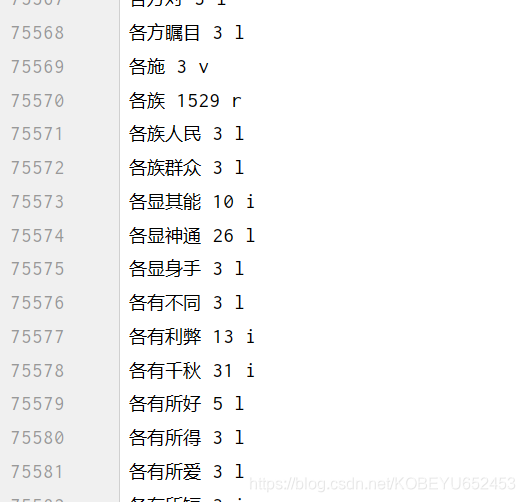概述
文本纠错又称为拼写错误或者拼写检查,由于纯文本往往来源于手打或者OCR识别,很可能存在一些错误,因此此技术也是一大关键的文本预处理过程,一般存在两大纠错类型。
1拼写错误
第一种是Non-word拼写错误,表示此词汇本身在字典中不存在,比如把“要求”误写为“药求”,
2.少字多字
中文文本纠错比较难,不多说。上思路
方法有很多,本文讲解基于拼音
思路:
1首先:本地得有一个正确字词的数据库 。命名 数据库.txt
格式:第一列正确字词,第二列 词频 ,第三列 词性
本文只用词和词频。考虑词性太难啦

2.得有一个文档txt,供编辑距离函数操作的。命名 编辑距离.txt
如下图

3.加载 数据库.txt 和 编辑距离.txt
4 输入一个错误单词(句子分词得到的单词,或者单独一个错误单词),计算编辑距离,生成编辑距离词集。
编辑距离需要比对 数据库.txt 的单词,计算距离
然后对错误单词进行删除字,增加字,修改字,替换字。增加删除替换哪些字呀,肯定得从 编辑距离.txt 文档里选取字插入或替换到错误单词里。 最后生成编辑距离词集
5 生成的编辑距离词集 肯定含有一些错误单词,找出同时在编辑距离词集和数据库.txt 的单词 ,即为我们候选正确词集
6. 对候选正确词进行分级。首先 pinyin.get得到错误词的拼音
然后遍历 候选正确词集的单词,求取得拼音。
我们根据候选词的拼音对其重要性进行排序
如果候选词的拼音与错误词完全匹配,则将候选词放入一级数组
#如果候选词的第一个词的拼音与错误词的第一个词匹配,我们将其按二级数组。否则我们把候选短语放入三级数组.
7.找到正确单词
如果一级数组存在, 得到 的正确字词是在 数据库.txt 中的。 考虑到得到的词可能有多个,前文提到数据库.txt 第一列是词,第二列是词频 。我们应该返回一级数组中 词在数据库.txt 中词频最大的那个单词
如果一级数组不存在,二级数组存在,,返回词频最大的那个单词
否则:返回三级数组词频最大的那个单词。
算例
代码:
1导入包 和标点符号
#!/usr/bin/env python3
# -*- coding: utf-8 -*-
# @Author: yudengwu
# @Date : 2020/6/22
import sys
import pinyin
import jieba
import string
import re
#标点符号
PUNCTUATION_LIST = string.punctuation # 标点符号!"#$%&'()*+,-./:;<=>?@[\]^_`{|}~
PUNCTUATION_LIST += "。,?:;{}[]‘“”《》/!%……()" # 添加额外标点符号
2读取 数据库.txt
只读取第一列和第二列 ,最后生成字典。
#得到的是各单词词频,如:{‘老师上课’: ‘3’, ‘老师傅’: ‘62’, ‘老师宿儒’: ‘老师上课’: ‘3’, ‘老师傅’: ‘62’, }
#统计个单词的词频
def construct_dict(file_path):
word_freq = {}
with open(file_path, "r",encoding='utf-8') as f:
for line in f:
info = line.split()
word = info[0]
frequency = info[1]
word_freq[word] = frequency
return word_freq
FILE_PATH = "token_freq_pos%40350k_jieba.txt"
phrase_freq = construct_dict( FILE_PATH ) #得到的是各单词词频,如:{'老师上课': '3', '老师傅': '62', '老师宿儒': '老师上课': '3', '老师傅': '62', }
3.读取编辑距离.txt
import pinyin
#载入编辑距离的单词列表
#cn_words_dict 用于编辑距离的,从里面选择字来菜如或者替换目标词
def load_cn_words_dict( file_path ):
cn_words_dict = ""
with open(file_path, "r",encoding='utf-8') as f:
for word in f:
cn_words_dict += word.strip()#去除首尾空格
return cn_words_dict
cn_words_dict = load_cn_words_dict("cn_dict.txt")#导入单字
4. 计算错误单词与数据库.txt里的单词的编辑距离
#函数计算与中文短语的距离
#cn_words_dict 用于编辑距离的,从里面选择字来菜如或者替换目标词
def edits1(phrase, cn_words_dict):
"`所有的编辑都是一个编辑远离'短语."
#phrase = phrase.decode("utf-8")
splits = [(phrase[:i], phrase[i:]) for i in range(len(phrase) + 1)]#将单词前后分开
deletes = [L + R[1:] for L, R in splits if R]#删除
transposes = [L + R[1] + R[0] + R[2:] for L, R in splits if len(R)>1]#转换
replaces = [L + c + R[1:] for L, R in splits if R for c in cn_words_dict]#替换
inserts = [L + c + R for L, R in splits for c in cn_words_dict]#插入
return set(deletes + transposes + replaces + inserts)
#编辑距离生成的词是否在我们前面得到的{词:词频}列表里,是就返回
5.找到候选正确词集 。即编辑距离生成的词同时又在数据库.txt里的词
#编辑距离生成的词是否在我们前面得到的{词:词频}列表里,是就返回
def known(phrases):
return set(phrase for phrase in phrases if phrase in phrase_freq)
6.计算拼音,得到一级数组,二级数组,三级数据。对候选正确词进行分级
#得到错误短语的候选短语
#我们根据候选词的拼音对其重要性进行排序
#如果候选词的拼音与错误词完全匹配,则将候选词进行一级数组
#如果候选词的第一个词的拼音与错误词的第一个词匹配,我们将其按二级数组
#否则我们把候选短语放入第三个数组
def get_candidates(error_phrase):
candidates_1st_order = []
candidates_2nd_order = []
candidates_3nd_order = []
#pinyin.get,get使用一个简单的get()函数,则可以返回拼音的符号,format="strip"去掉音调, delimiter="/"拼音之间的分隔符
error_pinyin = pinyin.get(error_phrase, format="strip", delimiter="/")#错误拼音
error_pinyin=str(error_pinyin)#转换成字符串格式,为后面选择拼音打下基础
cn_words_dict = load_cn_words_dict("cn_dict.txt")#导入单字
candidate_phrases = list(edits1(error_phrase, cn_words_dict))#编辑距离生成的候选词组
for candidate_phrase in candidate_phrases:#遍历编辑距离生成的候选词组
candidate_pinyin = pinyin.get(candidate_phrase, format="strip", delimiter="/")#候选词拼音
candidate_pinyin=str(candidate_pinyin)
if candidate_pinyin == error_pinyin: # 如果错误词拼音等于候选词拼音,则加入第一选择
candidates_1st_order.append(candidate_phrase)
elif candidate_pinyin.split("/")[0] == error_pinyin.split("/")[0]:
candidates_2nd_order.append(candidate_phrase)
else:
candidates_3nd_order.append(candidate_phrase)#否则加入第三个
return candidates_1st_order, candidates_2nd_order, candidates_3nd_order
7.找到正确单词
#自动更正单词
def auto_correct(error_phrase):
c1_order, c2_order, c3_order = get_candidates(error_phrase)#得到的候选正确词
# print c1_order, c2_order, c3_order
value1,value2,value3 = [],[],[]
if c1_order:
for i1 in c1_order:
if i1 in phrase_freq:
value1.append(i1)
return (max(value1, key=phrase_freq.get))
#一级候选存在,如果候选词拼音与错误单词完全正确,则返回候选词词频最大的单词
elif c2_order:
for i2 in c2_order:
if i2 in phrase_freq:
value2.append(i2)
return (max(value2, key=phrase_freq.get))
#一级候选不存在,二级候选存在,返回二级候选词频最大的词
else:
for i3 in c3_order:
if i3 in phrase_freq:
value3.append(i3)
return(max(value3, key=phrase_freq.get))
#否则,返回三级候选词频最大的
8.测试 对一个句子进行分词 ,然后每个单词 拿去寻找正确单词 ,最后将这些词拼接为正确句子
#对于任何一个给定的句子,用结巴做分词,
#割完成后,检查word_freq dict中是否存在剩余的短语,如果不存在,则它是拼写错误的短语
#使用auto_correct函数纠正拼写错误的短语
#输出正确的句子
def auto_correct_sentence(error_sentence, verbose=True):
jieba_cut = jieba.cut(error_sentence, cut_all=False)
seg_list = "\t".join(jieba_cut).split("\t") # 分词
correct_sentence = ""
for phrase in seg_list:
correct_phrase = phrase # 当前词语
if phrase not in PUNCTUATION_LIST: # 去除标点符号
if phrase not in phrase_freq.keys():
correct_phrase = auto_correct(phrase) # 对当前学习进行修正
if True:
print(phrase, correct_phrase)
correct_sentence += correct_phrase
return correct_sentence
9.主函数
def main():
errsent = '重庆是中国的四大火炉之一,因风景锈丽,是"人间天棠"!'
print("测试 :")
correct_sent = auto_correct_sentence(errsent)
print("原始文本:" + errsent + "\n==>\n" + "修正后的文本:" + correct_sent)
if __name__ == "__main__":
main()
结果:

本文有借鉴他人 。它给的代码跑不通。。 自己改了改代码
全文代码:
#!/usr/bin/env python3
# -*- coding: utf-8 -*-
# @Author: yudengwu
# @Date : 2020/6/22
import sys
import pinyin
import jieba
import string
import re
PUNCTUATION_LIST = string.punctuation # 标点符号!"#$%&'()*+,-./:;<=>?@[\]^_`{|}~
PUNCTUATION_LIST += "。,?:;{}[]‘“”《》/!%……()" # 添加额外标点符号
#统计个单词的词频
def construct_dict(file_path):
word_freq = {}
with open(file_path, "r",encoding='utf-8') as f:
for line in f:
info = line.split()
word = info[0]
frequency = info[1]
word_freq[word] = frequency
return word_freq
FILE_PATH = "token_freq_pos%40350k_jieba.txt"
phrase_freq = construct_dict( FILE_PATH ) #得到的是各单词词频,如:{'老师上课': '3', '老师傅': '62', '老师宿儒': '老师上课': '3', '老师傅': '62', }
#构建一个自动更正
"""
为拼写错误的短语创建一个自动更正器,我们使用编辑距离为拼写错误的短语创建一个正确的候选列表
根据是正确短语的可能性对正确候选列表进行排序
以下规则:
如果候选的拼音与拼写错误的短语的拼音完全匹配,我们将候选按第一顺序排列,这意味着他们是最有可能被选中的短语。
否则,如果候选的第一个单词的拼音与拼写错误的短语的第一个单词的拼音匹配,我们就输入第二个顺序的候选者
否则,我们将候选对象按三阶排序
"""
import pinyin
#载入编辑距离的单词列表
#cn_words_dict 用于编辑距离的,从里面选择字来菜如或者替换目标词
def load_cn_words_dict( file_path ):
cn_words_dict = ""
with open(file_path, "r",encoding='utf-8') as f:
for word in f:
cn_words_dict += word.strip()#去除首尾空格
return cn_words_dict
cn_words_dict = load_cn_words_dict("cn_dict.txt")#导入单字
#函数计算与中文短语的距离
#cn_words_dict 用于编辑距离的,从里面选择字来菜如或者替换目标词
def edits1(phrase, cn_words_dict):
"`所有的编辑都是一个编辑远离'短语."
#phrase = phrase.decode("utf-8")
splits = [(phrase[:i], phrase[i:]) for i in range(len(phrase) + 1)]#将单词前后分开
deletes = [L + R[1:] for L, R in splits if R]#删除
transposes = [L + R[1] + R[0] + R[2:] for L, R in splits if len(R)>1]#转换
replaces = [L + c + R[1:] for L, R in splits if R for c in cn_words_dict]#替换
inserts = [L + c + R for L, R in splits for c in cn_words_dict]#插入
return set(deletes + transposes + replaces + inserts)
#编辑距离生成的词是否在我们前面得到的{词:词频}列表里,是就返回
def known(phrases):
return set(phrase for phrase in phrases if phrase in phrase_freq)
#得到错误短语的候选短语
#我们根据候选词的拼音对其重要性进行排序
#如果候选词的拼音与错误词完全匹配,则将候选词进行一级数组
#如果候选词的第一个词的拼音与错误词的第一个词匹配,我们将其按二级数组
#否则我们把候选短语放入第三个数组
def get_candidates(error_phrase):
candidates_1st_order = []
candidates_2nd_order = []
candidates_3nd_order = []
#pinyin.get,get使用一个简单的get()函数,则可以返回拼音的符号,format="strip"去掉音调, delimiter="/"拼音之间的分隔符
error_pinyin = pinyin.get(error_phrase, format="strip", delimiter="/")#错误拼音
error_pinyin=str(error_pinyin)#转换成字符串格式,为后面选择拼音打下基础
cn_words_dict = load_cn_words_dict("cn_dict.txt")#导入单字
candidate_phrases = list(edits1(error_phrase, cn_words_dict))#编辑距离生成的候选词组
for candidate_phrase in candidate_phrases:#遍历编辑距离生成的候选词组
candidate_pinyin = pinyin.get(candidate_phrase, format="strip", delimiter="/")#候选词拼音
candidate_pinyin=str(candidate_pinyin)
if candidate_pinyin == error_pinyin: # 如果错误词拼音等于候选词拼音,则加入第一选择
candidates_1st_order.append(candidate_phrase)
elif candidate_pinyin.split("/")[0] == error_pinyin.split("/")[0]:
candidates_2nd_order.append(candidate_phrase)
else:
candidates_3nd_order.append(candidate_phrase)#否则加入第三个
return candidates_1st_order, candidates_2nd_order, candidates_3nd_order
#自动更正单词
def auto_correct(error_phrase):
c1_order, c2_order, c3_order = get_candidates(error_phrase)#得到的候选正确词
# print c1_order, c2_order, c3_order
value1,value2,value3 = [],[],[]
if c1_order:
for i1 in c1_order:
if i1 in phrase_freq:
value1.append(i1)
return (max(value1, key=phrase_freq.get))
#一级候选存在,如果候选词拼音与错误单词完全正确,则返回候选词词频最大的单词
elif c2_order:
for i2 in c2_order:
if i2 in phrase_freq:
value2.append(i2)
return (max(value2, key=phrase_freq.get))
#一级候选不存在,二级候选存在,返回二级候选词频最大的词
else:
for i3 in c3_order:
if i3 in phrase_freq:
value3.append(i3)
return(max(value3, key=phrase_freq.get))
#否则,返回三级候选词频最大的
#
#对于任何一个给定的句子,用结巴做分词,
#割完成后,检查word_freq dict中是否存在剩余的短语,如果不存在,则它是拼写错误的短语
#使用auto_correct函数纠正拼写错误的短语
#输出正确的句子
def auto_correct_sentence(error_sentence, verbose=True):
jieba_cut = jieba.cut(error_sentence, cut_all=False)
seg_list = "\t".join(jieba_cut).split("\t") # 分词
correct_sentence = ""
for phrase in seg_list:
correct_phrase = phrase # 当前词语
if phrase not in PUNCTUATION_LIST: # 去除标点符号
if phrase not in phrase_freq.keys():
correct_phrase = auto_correct(phrase) # 对当前学习进行修正
if True:
print(phrase, correct_phrase)
correct_sentence += correct_phrase
return correct_sentence
def main():
errsent = '重庆是中国的四大火炉之一,因风景锈丽,是"人间天棠"!'
print("测试 :")
correct_sent = auto_correct_sentence(errsent)
print("原始文本:" + errsent + "\n==>\n" + "修正后的文本:" + correct_sent)
if __name__ == "__main__":
main()
来源# @Author: yudengwu